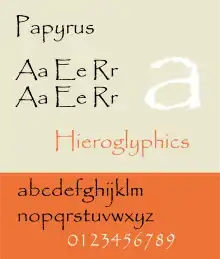Papyrus (typeface)
Papyrus is a widely available typeface designed by Chris Costello, a graphic designer, illustrator, and web designer. Created in 1982, it was hand-drawn over a period of six months by means of calligraphy pen and textured paper. Papyrus has a number of distinctive characteristics, including rough edges, irregular curves, and high horizontal strokes in the capitals.
 | |
| Category | Fantasy |
|---|---|
| Designer(s) | Chris Costello |
| Foundry | Letraset |
| Date created | 1982 |
| Date released | 1983 |
| Re-issuing foundries | Linotype ITC |
| Shown here | Papyrus EF Alternatives |
History and overview
Costello created the font in 1982 when he was 23 years old and just out of college. He had been studying the Bible and came onto the idea of what a written font would have looked like in biblical times in the Middle East.[1] He hand-drew the font over a period of six months by means of calligraphy pen and textured paper. Costello described his goal as a font that would represent what English language texts would have looked like if written on papyrus 2,000 years ago.[2] Costello released the font the following year alongside Letraset. Papyrus has a number of distinctive characteristics, including rough edges, irregular curves, and high horizontal strokes in the capitals. ITC, the current owner of the typeface, describes it as an "unusual roman typeface [that] effectively merges the elegance of a traditional roman letterform with the hand-crafted look of highly skilled calligraphy".[3] Costello sold the rights to the font for $750, and as of 2017, states he still receives "very low" royalty payments despite its inclusion since 2000 on all personal computers using a Mac or Microsoft operating system.[1] In October 2017, Costello agreed that Papyrus had become overused.[4]
Variants
An alternative font published by Elsner+Flake is Papyrus EF Alternatives (or Papyrus EF Regular), providing a slight variation to Costello's font. Its differences include a shorter, sharper capital P, a capital E with a top bar longer than the middle bar, and a swash A.
Availability
Papyrus has been included in many Microsoft programs for Windows.[5] macOS includes Papyrus font as part of its basic installation (starting with version 10.3 Panther, released in 2003).[6]
In popular culture
The typeface was used for the subtitles that appear in James Cameron's 2009 movie Avatar,[7] with a modified form used for the movie's title. In 2017, the use of Papyrus in Avatar was highlighted in a Saturday Night Live sketch featuring Ryan Gosling.[8][1] The film's Disney+ release replaces Papyrus with another typeface.[9]
In the 2015 video game Undertale, the skeleton character Papyrus is named after the font, and his dialogue is displayed in all caps Papyrus. He is paired with his brother Sans, himself named after the font Comic Sans.[10]
References
- Carissimo, Justin (October 1, 2017). "Papyrus font creator reacts to viral "Avatar" skit from "Saturday Night Live"". CBS News. Retrieved October 1, 2017.
- Costello, Chris (2003). "2003 Interview". Chris Costello official site. Retrieved 2015-12-05.
I soon came up with what vernacular writing may have looked like if the English language existed 2000 years ago.
- "Type Gallery – Papyrus". Linotype. Retrieved 2015-11-29.
- https://techcrunch.com/2017/10/03/papyrus-creator-speaks-out-after-ryan-gosling-roasts-the-font-on-snl/
- "Microsoft Typography: Papyrus – Version 1.11". Microsoft Corporation.
- "Mac OS X 10.3: Fonts list". Apple Inc. Last updated 2008-07-24.
- Simon Garfield (2010). Just My Type: A Book about Fonts. Profile Books. ISBN 1-84668-301-7.
- Kennedy, Mark (October 1, 2017). "New Season of SNL Roars Back by Mocking Donald Trump Early". U.S. News & World Report. AP.
- Stolworthy, Jacob (24 March 2020). "Disney+ makes key Avatar change to delight of fans". The Independent. Retrieved 26 March 2020.
- Sotomayor, Bella Vanessa (December 15, 2016). "UNDERTALE: A Game That Is Still Amazing Today". ComicsVerse. Retrieved 20 March 2020.
Some of the characters also have different fonts in their text boxes, which highlights their different personalities. For example, two brothers named Sans and Papyrus use the comic sans and papyrus fonts in their text boxes, respectively.